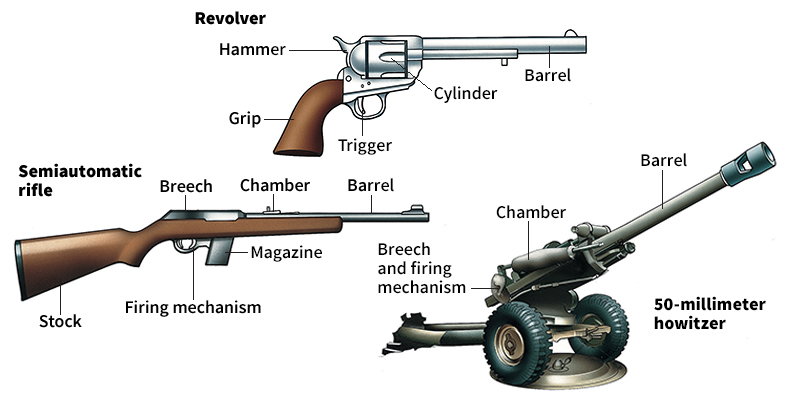Firearm is any device that uses gunpowder to fire a bullet or shell. Generally, the term is used for light firearms. Light firearms include rifles, machine guns, shotguns, and pistols. Light firearms are often called small arms. Heavier firearms are generally referred to as artillery.

Mechanism.
Any firearm, large or small, has four essential parts. Those parts are a barrel, chamber, breech mechanism, and firing mechanism. The barrel is a long tube. Its interior may be smooth, as in a shotgun. Or it may have rifling (spiral grooves), as in most handguns and rifles. The chamber is a widened hole at the breech (rear) end of the barrel. It holds the cartridge (explosive charge). The breech mechanism closes the rear end of the barrel, holding the cartridge in the chamber. The breech of every modern firearm can be opened for loading. The breech can also be locked for safety in firing. Small arms usually have a metal cylinder, or bolt, that is locked when the gun is fired. After firing, the bolt draws back to eject (force out) the empty cartridge case and to reload. Artillery uses screw plugs or breechblocks.
The firing mechanism ignites the powder in a firearm. In some large artillery pieces, this mechanism is an electric device. In small arms, a spring drives a pointed firing pin through the breech bolt. The firing pin strikes a primer (tiny explosive charge) in the cartridge. The firing pin is cocked (drawn back) against a hook called the sear. When the trigger is pulled, the sear releases the pin. The firing pin, in turn, snaps forward to strike the primer. A jet of flame from the primer ignites the rest of the powder, creating a gas. Pressure caused by rapid expansion of the gas propels the bullet from the barrel.
A device called a safety is intended to prevent a firearm from firing accidentally if it is dropped or if it snags on an object. However, safeties on most long guns, such as rifles and shotguns, block the trigger but not the hammer or firing pin. Thus, such guns can fire when dropped.

History.
The Chinese invented gunpowder before A.D. 900. As early as the first half of the 1100’s, they may have used a handheld firearm that resembled a small cannon. Travelers brought gunpowder from Asia to Europe in the 1200’s. Beginning in the 1300’s, Europeans developed cannons. Smaller handheld firearms followed. See Gunpowder .
The invention of firearms led to great changes in warfare. Bullets could penetrate armor. Powerful, accurate cannons could destroy castle walls. However, early handheld weapons were heavy and clumsy. In addition, soldiers had to load the firearms from the muzzle.

The rifle was invented about 1500. The spiral grooves in its barrel made it more accurate than any previous firearm. Smokeless powder was developed in the 1800’s. Breechloading systems replaced dangerous muzzle loading. Many improvements since have resulted in high-powered firearms.
